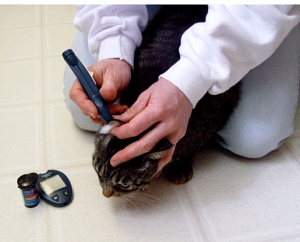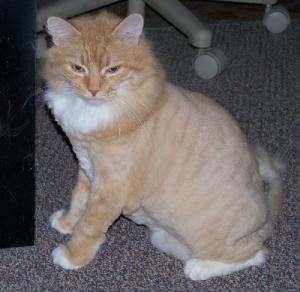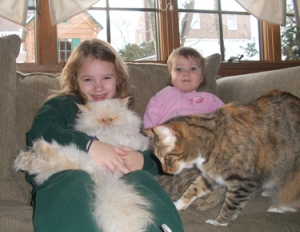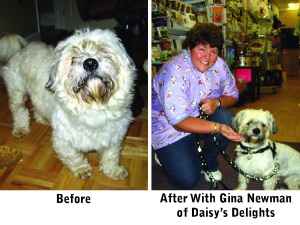How The Sugar Cat Got His Mojo Back!
In part one of our article on feline diabetes, we examined the types of diabetes, symptoms to watch for, and what to expect during a vet visit. Now we are ready to discuss the treatment options, the various types of insulin, and how you can do your own home monitoring of your cat’s blood glucose levels–saving you time, trips to the vet, and money, not to mention less stress for your cat!
1: Proper Diet without question is the first order of business in management of diabetes. Cats are “obligate carnivores.” Obligate carnivores may eat other foods, such as vegetables, grains, or fruit, but they must eat meat as the main source of their nutrients. Cats who regularly consume a diet of poor-quality, highly processed, carbohydrate-rich food are on the fast track to becoming diabetic. The appropriate diet for a diabetic cat is a diet that is very low in carbs, low to moderate in fat, and high in proteins. (Sort of an “Atkins” diet for cats–the “Catkins” diet!)
Veterinarians usually prescribe a veterinary diet such as Purina DM, or Hills W/D or M/D. Elizabeth Hodgkins, DVM, a veterinarian who has done extensive research on feline diabetes, also suggests that several very good commercially-made wet foods that will meet a diabetic cat’s needs. Many varieties of Fancy Feastcanned food meet the high protein/low carb requirements–plus the cat enjoys eating the food as it is very tasty. Blue Buffalo also produces an excellent food called “Blue Wilderness” that is mostly meat, high in protein, and low in carbs.
Sometimes merely putting the cat on the recommended diet is enough to “kick-start” the cat’s pancreas into producing insulin, and thus avoid having to inject insulin. However, this is not always the case with cats in a more acute stage such as cats with Type I diabetes.
2: Proper Insulin is essential in managing blood glucose levels. There are several types of insulin currently in use by veterinarians. Protamine zinc insulin (PZI, or Pro-Zinc) is a very effective insulin primarily due to the fact that it is animal-based, comprised of beef and pork insulin molecules which more closely resemble natural feline insulin. It can be given at 6-12 hour intervals, allowing for good control of the diabetic cat. Other insulins currently in use include Humulin insulin, Lantus (glargine), or Levemir. Although these are all products geared for use in humans, studies have shown them to be effective in veterinary use. Your veterinarian will choose an insulin that is appropriate for your particular cat. Proper insulin syringes are important as well as they come in many different sizes and gauges. Your veterinarian will determine the appropriate size for the type of insulin for your cat.
Insulin syringes have a very thin, tiny needle and it is really very easy to inject into your cat. The insulin must be refrigerated, and it must always be mixed prior to giving an injection. This is not done by shaking the bottle, as insulin is fragile and you can damage the insulin that way. “Mix” insulin by taking the bottle, placing it between the palms of our two hands, and very gently rolling the bottle between our palms. Then we can draw the insulin from the bottle with the syringe and inject. Your veterinarian will show you how and where to give the injections. Typically it’s done further back around the hips or flank or, ideally, on the sides of the stomach. Try to rotate sites also, because repeated injections in the same site can cause a “granuloma” or knot of tissue that has poor blood supply.
3: Tight Management of Blood Glucose is the third component in managing your cat’s diabetes-and this is why home blood glucose testing has become so effective, and essential. For around $20, a blood glucose meter–just like people use–can be purchased at your local pharmacy. The most expensive part of home monitoring is the test strips for the meter. Each different meter manufacturer requires their own test strips to be used, they are not interchangeable. It pays to shop around, and some of the best pricing can be found on diabetic supply websites such as AmericanDiabetesWholesale.com.

Cats can grow accustomed to having their blood sugar monitored.
Now, how exactly do you test your cat? We use the outer portion of their ear. The outer edge of a cat’s ear has very thin skin; it’s very easy to “lance” that spot of their ear. You do not need much blood, only about a drop the size of a pinhead. Once you have a droplet, then you take the meter with the test strip, dip the test strip in the droplet, and you will get a reading in about 5 seconds. Your veterinarian should be able to have one of their technicians demonstrate this for you as most veterinarians keep blood glucose meters in their offices. There is also an excellent video demonstration on YouTube.
By monitoring your cat’s blood glucose levels on a regular basis, you can see the gradual change in their daily levels, enter the readings into a log book or setup a spreadsheet in Excel, and review the readings with your vet. We followed this protocol with Miss Garfield, the diabetic cat I am fostering. When she was initially diagnosed with diabetes in October of 2010, her glucose levels were literally off the chart. When I first began testing her, her readings were over 600. Our veterinarian began with a regimen of 5 units of PZI insulin 2x per day. I was then testing her daily, and as our readings began to drop, we were able to adjust her insulin appropriately.
As of April 1, 2011 her readings were consistently in the 75-150 range so we took her off insulin–and she has been off ever since. I test her now about once a week just to make sure she’s maintaining normal levels. We are managing her with diet alone, she does not get stressed at all about doing the readings as she is used to it, and we save countless trips to the vet!
Editor’s Note added 7/20/11: Even though PZI and Humulin are very popular insulin protocols, we’d like to make note of the fact that not every insulin has to be mixed, in particular Lantus or Levemir insulin. When using either Lantus or Levemir, do not roll, shake or mix the insulin in any way. They are gentle, long lasting insulins that work great, in fact Lantus is one of the mostly widely prescribed insulins right now for feline diabetes, but if you roll or shake the vial, you will degrade the insulin and render it ineffective.
And thanks to Jennifer from FelineDiabetes.com for the reminder!
Acknowledgement to the following websites for valuable information:Feline Diabetes, Dr. Elizabeth Hodgkin’s website, Your Diabetic Cat, and Dr. Lisa Pierson’s website, Cat Info.














